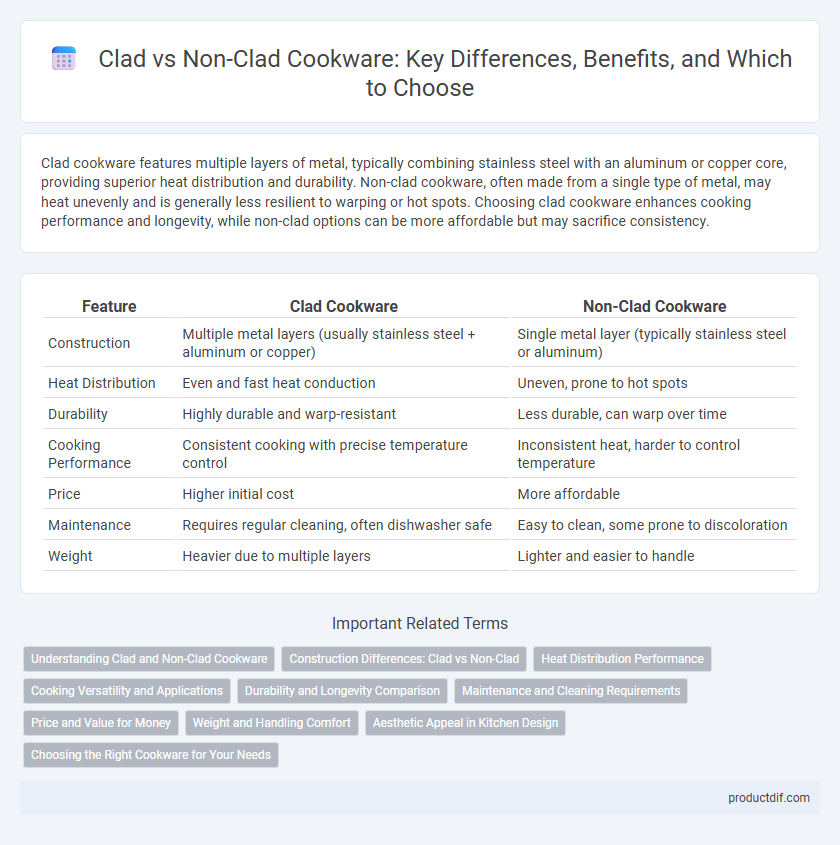Clad cookware features multiple layers of metal, typically combining stainless steel with an aluminum or copper core, providing superior heat distribution and durability. Non-clad cookware, often made from a single type of metal, may heat unevenly and is generally less resilient to warping or hot spots. Choosing clad cookware enhances cooking performance and longevity, while non-clad options can be more affordable but may sacrifice consistency.
Table of Comparison
| Feature | Clad Cookware | Non-Clad Cookware |
|---|---|---|
| Construction | Multiple metal layers (usually stainless steel + aluminum or copper) | Single metal layer (typically stainless steel or aluminum) |
| Heat Distribution | Even and fast heat conduction | Uneven, prone to hot spots |
| Durability | Highly durable and warp-resistant | Less durable, can warp over time |
| Cooking Performance | Consistent cooking with precise temperature control | Inconsistent heat, harder to control temperature |
| Price | Higher initial cost | More affordable |
| Maintenance | Requires regular cleaning, often dishwasher safe | Easy to clean, some prone to discoloration |
| Weight | Heavier due to multiple layers | Lighter and easier to handle |
Understanding Clad and Non-Clad Cookware
Clad cookware features multiple layers of metal bonded together, typically combining stainless steel with an aluminum or copper core for enhanced heat conductivity and even cooking. Non-clad cookware usually consists of a single metal layer, which may result in hot spots and less consistent heat distribution. Understanding the differences between clad and non-clad options helps in selecting cookware suited for precision cooking and durability.
Construction Differences: Clad vs Non-Clad
Clad cookware features multiple layers of metal, typically combining stainless steel with an aluminum or copper core for superior heat distribution and retention. Non-clad cookware usually consists of a single layer, often stainless steel or aluminum, which may cause uneven heating and hot spots during cooking. The multi-layer construction of clad cookware improves durability and temperature control, making it a preferred choice for professional and home chefs alike.
Heat Distribution Performance
Clad cookware features multiple layers of metal, typically combining stainless steel with an aluminum or copper core, which ensures superior heat distribution and minimizes hot spots. In contrast, non-clad cookware often has a single metal layer, resulting in uneven heating and increased risk of burning or undercooking food. The multi-layer construction in clad cookware delivers consistent temperature control, enhancing cooking precision and efficiency.
Cooking Versatility and Applications
Clad cookware features multiple bonded metal layers, typically stainless steel and aluminum, providing superior heat distribution and versatility for diverse cooking techniques, from searing to simmering. Non-clad pans, often made from single metals like cast iron or carbon steel, excel in specific applications such as high-heat searing or seasoning-dependent frying but lack the uniform heating of clad options. Choosing clad cookware enhances overall kitchen performance by accommodating a wider range of recipes and cooking styles, while non-clad pieces serve targeted, specialized culinary tasks.
Durability and Longevity Comparison
Clad cookware, constructed with multiple bonded metal layers, offers superior durability and resistance to warping compared to non-clad cookware, which typically uses a single metal type. Stainless steel clad pans often feature an aluminum or copper core that enhances heat distribution and prevents structural degradation over time. Non-clad cookware, while sometimes less expensive, generally shows faster wear, reduced lifespan, and diminished performance due to uneven heat conduction and susceptibility to corrosion.
Maintenance and Cleaning Requirements
Clad cookware features layers of metal bonded together, providing superior heat distribution and durability that simplifies cleaning by preventing food from sticking. Non-clad cookware, often made from a single metal like stainless steel or aluminum, requires more careful maintenance to avoid warping and discoloration, and typically demands thorough scrubbing to remove residue. Using gentle cleaning agents and avoiding abrasive materials helps extend the lifespan of both clad and non-clad cookware while maintaining their cooking performance.
Price and Value for Money
Clad cookware, composed of multiple bonded metal layers like stainless steel and aluminum, generally costs more upfront but delivers superior heat distribution and durability, offering better long-term value for money. Non-clad cookware tends to be less expensive initially but often sacrifices even heating and longevity, potentially leading to higher replacement costs over time. Investing in mid to high-end clad cookware provides a balance of price and performance, making it a cost-effective choice for serious home cooks.
Weight and Handling Comfort
Clad cookware features a layered construction, typically combining aluminum or copper cores bonded with stainless steel, resulting in a balanced weight that enhances handling comfort and precise temperature control. Non-clad cookware, often made from a single material like stainless steel or cast iron, tends to be heavier and less maneuverable, which can cause hand fatigue during prolonged use. Choosing clad cookware improves ease of handling and reduces strain, especially beneficial for cooks requiring agility and comfort during food preparation.
Aesthetic Appeal in Kitchen Design
Clad cookware features a sleek, polished exterior with a distinctive layered design that enhances modern kitchen aesthetics. Non-clad cookware often has a simpler, utilitarian look, which may not contribute as strongly to a contemporary or high-end kitchen style. Choosing clad cookware can elevate the visual appeal of open shelving or countertop displays, adding both luxury and sophistication to kitchen design.
Choosing the Right Cookware for Your Needs
Clad cookware offers superior heat distribution and durability by combining multiple metal layers, typically stainless steel and aluminum or copper, making it ideal for precision cooking and even heat retention. Non-clad cookware, often made from single-material metals like cast iron or non-stick aluminum, provides benefits such as affordability, lightweight handling, and easy maintenance, suitable for basic or casual cooking needs. Selecting the right cookware depends on your cooking style, heat control preferences, and budget, with clad cookware excelling in professional settings and non-clad options serving well for everyday, low-maintenance use.
Clad vs Non-Clad Infographic

 productdif.com
productdif.com